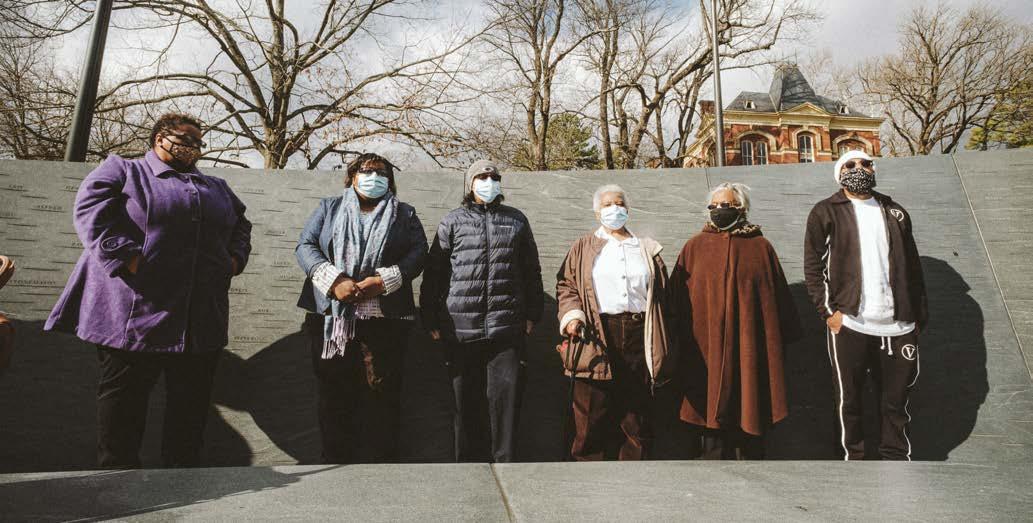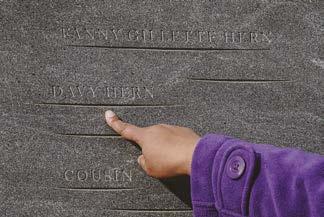
6 minute read
Five new names are added to UVA’s enslaved laborers memorial
Since the policy went into effect on January 10, those who cannot do the extra shifts have been allowed to find another person to work it for them. But that can be difficult when everyone is desperate for a break.
“When I go home I don’t have the energy to cook. I don’t want to clean. This is at the expense of the rest of our lives,” adds the part-time nurse aide. “We’re here because we like to help people, and want to give as much as we can—but if that’s not sustainable, who does that help?”
Advertisement
In addition to mandating extra shifts, the hospital continues to shuffle nurses around outside of their normal units, meaning nurses are often performing jobs that aren’t as well-suited to their skill set.
“We’re seeing an increase in patient to nurse ratios in a lot of the non-COVID units, which is of course dangerous for those patients and for staff,” says the nurse aide.
While the new policy is supposed to end in early April, the nurses fear it could last longer if the hospital does not ramp up its hiring.
“I know they are hiring people and bringing on travel nurses, but this is not a problem they can solve overnight,” says the aide. “They need to focus on keeping the nurses that they have now.”
“There are some newer nurses that have only been here for maybe a year or less who say they are thinking of leaving UVA altogether because of the way they are handling things and treating us,” adds Christmas.
According to Chief Nursing Officer Mary Dixon, reinforcements are on the way. Twenty-eight newly graduated nurses will be brought on staff next month. And every day, recruiters are actively looking for seasoned nurses to fill open positions.
Due to the pandemic, “nurse staffing is a challenge probably in almost every single health care institution. And under that challenge, recruitment also can be a challenge,” says Dixon.
“A lot of this [new policy] is really in preparation for the unknown, and making sure we have good plans in place if we were to take on more COVID patients,” says Medical Center CEO Wendy Horton.
“This is also a temporary measure, [and] we will continue to evaluate it over the coming weeks,” adds Dixon. “It was uncomfortable for our staff to have this request put to them...but many of our team at this moment in time are very grateful we are doing this.”
While the hospital works to hire more nursing staff, the nurse aide believes it should provide hazard pay for all shifts—not just the two extra ones—to help alleviate stress and burnout.
The part-time nurse aide appreciates the various mental health resources, from counseling to yoga, that the hospital has offered to employees during the pandemic, but thinks many haven’t had enough time off of work to take advantage of them.
In light of the extreme burden upon hospital staff, all three nurses call on the public to continue to follow safety guidelines, and help bring COVID cases and hospitalizations down.
“Just because the vaccine is in the news doesn’t mean the pandemic is over,” says the nurse aide. “These next couple of months are going to be treacherous until enough people get vaccinated.”
Etched in stone
New names added to Memorial to Enslaved Laborers
EZE AMOS
Myra Anderson (left) and other Hern family members attended a ceremony to add five of their ancestors’ names to UVA’s Memorial to Enslaved Laborers.
By Brielle Entzminger reporter@c-ville.com
At UVA’s Memorial to Enslaved Laborers, some people are remembered by name: Billy, Jane, Lewis. Others are remembered by occupation or relationship: Woodcutter, grandmother. And others still are represented by nothing more than gashes in the hard rock, denoting a life’s worth of details lost to history.
Standing in front of the wall, Myra Anderson’s eyes fell upon the name of her ancestor, Thirmston Hern, who had been enslaved at Monticello and sold to a university professor following the death of Thomas Jefferson.
Thirmston was not alone, Anderson learned. Five other members of his family were also sold and enslaved at the university—yet their names were not initially included on the University of Virginia’s memorial, which opened last year.
Earlier this month, however, Anderson’s five ancestors were finally etched into the granite wall: Davy Hern, Fanny Gillette Hern, Bonnycastle Hern, Lily Hern, and Ben Snowden.
The additions were unveiled to Anderson and her family during a small ceremony last week.
“It was a really heavy and emotional moment,” says Anderson, who grew up in Charlottesville. “It was more than just getting those names on the wall. It was really bringing dignity to my ancestors—slavery is something that robbed them of that.”
Since her ancestors were first enslaved at Monticello, Anderson was able to dig up estate sale records, along with books and documents, proving that the Herns had also
EZE AMOS

lived and worked at the university. In addition, she discovered that Thirmston, Davy, and Lily were siblings.
For over a year, she contacted various university faculty and staff, advocating for the Herns to be honored on the memorial wall. But because there was no established process for adding names to the monument, it took a while to connect with the right person.
“I don’t think it was an issue of reluctance or resistance, as much as it was process,” she says. “At times I did want to give up, but I thought about my ancestors and it’s not in my DNA to do that.”
In December, Anderson finally received an apology letter from the university, announcing that her ancestors would be added to the memorial the following month.
Anderson’s persistence ultimately led the university to establish an official MEL Names Committee, composed of historians, genealogists, alumni, architects, and descendants.
From 1812 to 1865, an estimated 4,000 people were enslaved at UVA, and each is represented by a deep gash carved into the memorial wall. But researchers have only been able to find the names of 588 enslaved people, along with 311 people known by their occupation or kinship relation, to put above the memory marks.
“The MEL Names Committee is dedicated to working with genealogists and seeing the 4,000 memory markers on the memorial filled with the names of enslaved laborers,” says Carolyn Dillard, head of the committee. “[But] this is not just about a memorial wall—this is talking about people’s hearts and families that have been divided. We want to make sure we are engaging with descendants respectfully.”
Though the university will continue to look for people to add to the memorial, descendant families are strongly encouraged to bring forward names to be validated by genealogists, says Dillard.
Every year, new names will be added to the wall, and unveiled at a ceremony for descendant families.
Anderson hopes that the new committee will make the approval process much easier for other descendant families, even those with very few historical records.
“My worry is for the descendants who will come along whose ancestors didn’t come from Monticello or some place that had all of these documentations. Because during slavery, records are hard to find,” she says.
“We want descendants to come forward to share any documentation that they have— even oral history,” says Dillard.
Anderson also calls on UVA to continue to address and rectify its racist past, such as by creating legacy scholarships for descendants of people enslaved at the university.
“This university has flourished off of the labor, blood, sweat, and tears of my ancestors and other enslaved laborers,” she says. “When you’re thinking of righting wrongs of the past, that seems like a no-brainer.”



